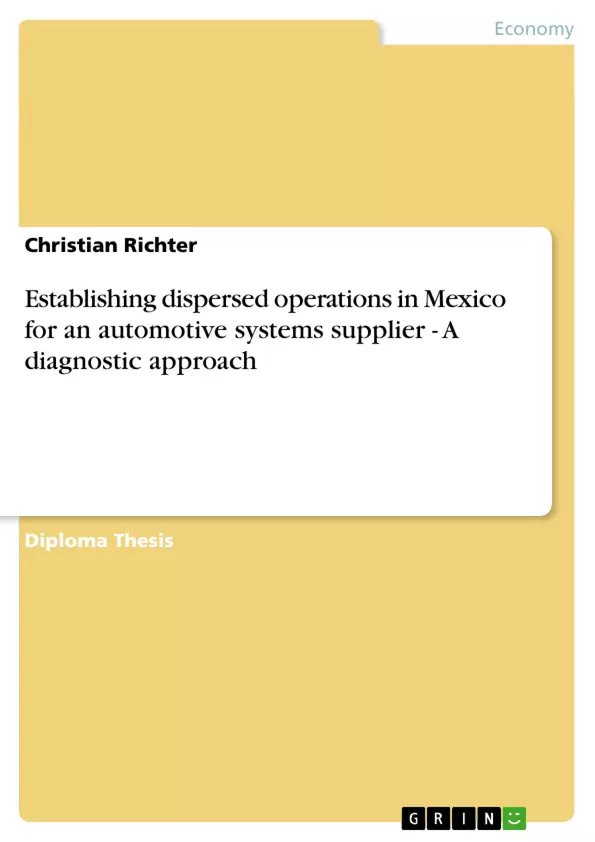Dispersing operations in foreign countries is not a development in only recent years
and we can face it almost daily in the newspapers and on TV. Not only by the takeover
waves among big multinational companies in the late nineties (for instance the lastly
loosed merger of Daimler and Chrysler) but also by the riots in the run-up to the 33rd
G8 Summit 2007 in Germany the issue of globalisation was spotlighted to the general
public.
Based on the economic research this diploma thesis addresses the topic of dispersed
operations and should give advice and instructions how to reach a successful access to
markets in foreign countries in practice. Since the international orientation of enterprises
cannot be generalised and is different (among other things) from branch to
branch the establishment of dispersed operations is examined for the example of an
automotive supplier starting business activities in Mexico. The automotive supply industry
seams to be very applicable for such an analysis as the traditionally very internationally
oriented automotive manufacturers, i.e. the customers of the suppliers, were
notably influenced by the consolidation processes in the last years and decades. Considering
this the question needs to be posed if this alteration of business conditions has
impacts on the suppliers as well.
The United Mexican States as one of the biggest economies in Latin America are a
quite popular location especially among the North American investors for a long time.
Mexico connects (not only physically) the huge markets of Canada and the United
States of America with the BRIC state of Brazil which is considered by many experts
to be the growth market of South America in the next years. Since all well-known
vehicle manufacturers run representations on the Mexican market it suggests examining
the international orientation of automotive suppliers in respect of especially this
market.
Inhaltsverzeichnis (Table of Contents)
- 0. Preface
- 1. The understanding of dispersed operations
- 2. The automotive supply industry: Status quo and global developments
- 2.1 The German automotive supply industry – Facts and figures
- 2.2 Abstract of trends in the global automotive supply industry
- 2.2.1 Development of the global automotive production
- 2.2.2 Increase of the automotive value
- 2.2.3 Value percentage of the automotive systems suppliers
- 2.3 The automotive supply industry in the flux: From components to systems supplier
- 3. Description and critical view on the forms of dispersed operations for an automotive systems supplier in Mexico
- 3.1 Export
- 3.2 Sales office
- 3.3 Production settlement – Maquiladora
- 3.4 Acquisition vs. formation of a company
- 3.5 Foreign Direct Investment
- 3.5.1 Wholly owned subsidiary
- 3.5.2 Joint Venture
- 4. Influencing factors for the prosperous exposure of an automotive systems supplier in Mexico
- 4.1 State and development of the Mexican economy and politics
- 4.1.1 Mexico - Facts and figures
- 4.1.2 The political situation in Mexico
- 4.2 The Mexican market for automotive systems
- 4.3 The choice of location
- 4.3.1 Sales potentials
- 4.3.2 Resource acquisition pool
- 4.3.3 Available skills pool
- 4.3.3.1 The personnel policy and expatriates management
- 4.3.3.2 Labour unions
- 4.3.3.3 Labour costs
- 4.4 Financials
- 4.5 Cross-cultural aspects of business activities in Mexico
- 4.1 State and development of the Mexican economy and politics
- 5. Conclusion
Zielsetzung und Themenschwerpunkte (Objectives and Key Themes)
This thesis investigates the establishment of dispersed operations in Mexico for an automotive systems supplier. It provides a comprehensive diagnostic approach analyzing relevant factors for successful market entry.
- Analyzing the current state and future trends in the global automotive supply industry.
- Evaluating different forms of dispersed operations, including export, sales offices, and production settlements.
- Identifying key influencing factors for successful market entry, such as the Mexican economy, political environment, and labor market.
- Exploring the role of cross-cultural aspects in business activities in Mexico.
- Developing recommendations for a successful strategy for establishing dispersed operations in Mexico for an automotive systems supplier.
Zusammenfassung der Kapitel (Chapter Summaries)
Chapter 1 introduces the concept of dispersed operations, outlining its relevance in the context of globalized markets. Chapter 2 provides an overview of the automotive supply industry, focusing on its current state and future developments. It examines the German automotive supply industry and analyzes trends in global automotive production, value creation, and the increasing importance of systems suppliers. Chapter 3 delves into various forms of dispersed operations for an automotive systems supplier in Mexico, examining advantages and disadvantages of export, sales offices, production settlements (Maquiladoras), and Foreign Direct Investment (FDI) strategies such as wholly owned subsidiaries and joint ventures.
Schlüsselwörter (Keywords)
This thesis focuses on the key concepts of dispersed operations, the automotive supply industry, Mexico, market entry, FDI, Maquiladora, cross-cultural aspects, and the Mexican economy.
- Citation du texte
- Christian Richter (Auteur), 2007, Establishing dispersed operations in Mexico for an automotive systems supplier - A diagnostic approach, Munich, GRIN Verlag, https://www.grin.com/document/80707



